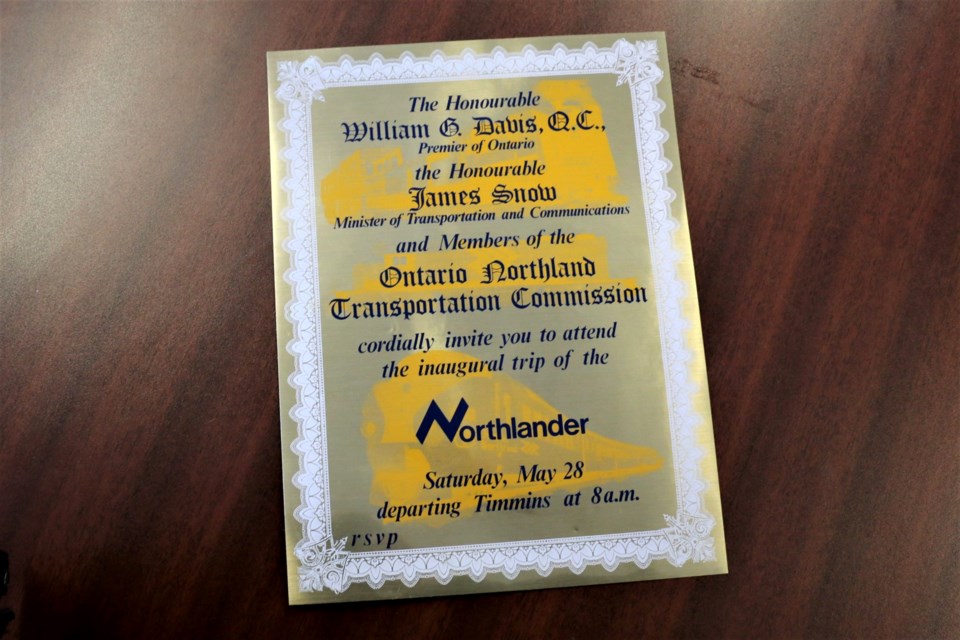It was reassuring to hear the announcement that came out last April that said Ontario Northland was reinstating the Northlander train service that will run from Toronto to Timmins and Cochrane. That's because the Northlander was cancelled in 2012 and replaced by highway bus service. Not a lot of Northerners were happy.
The newly reinstated passenger rail service will include all new trains — meaning new locomotives and new passenger cars.
The announcement brought back memories of riding the inaugural run of the 1970’s modern version of the Northlander on Saturday, May 28, 1977. I was working as a news reporter for CKSO Radio and Television.
There was considerable excitement not only because a new-to-the-North European-styled train was being used, but also because it was seen as an upgrade to run down passenger service that had previously been operated by Ontario Northland.
The new Northlander trains were refurbished TEE (Trans-Euro Express) trains purchased from the Dutch and Swiss railways. They featured a sleek, streamlined four-unit train that was made up of a diesel locomotive, a coach car, a dining car and a compartment car.
The trains were being replaced by all-electric trains in Europe and were put up for sale. Ontario Northland put in a bid.
By 1970s standards it was the coolest thing on rails in Ontario. The compartment car was unique by Canadian standards as it featured seven separate compartments, with seating for six passengers in each compartment.
Anyone riding the regular train out of Timmins early in the morning could move into a compartment, close the door and stretch out on one of the couch-style seats for a quick nap.
As the train headed south through places such as Matheson, Swastika and Englehart, more and more invited passengers would board the train and eventually most of the seats would be taken.
It was still nice to get a group of folks together in one of the compartments because Northerners like to chat and in no time there would be full-blown conversations about hockey, about politics and the great idea of having a new train to ride, whether one was merely travelling down the line to New Liskeard or North Bay, or going all the way to Toronto.
The inaugural run in 1977 had some added prestige by having a few Ontario cabinet ministers on board to mark the occasion.
One of them was then-Northern Affairs Minister Leo Bernier, a man who had legendary influence in the cabinet of Ontario premier Bill Davis. He was known as King of the North. Every mayor and reeve in Northern Ontario knew if they needed funding for a special project it was good to have Leo on your side.
Interestingly, the presence of well-known politicians resulted in the train making an unscheduled stop in the small town of Cobalt that morning.
It was only a few days earlier that a disaster had occurred in that town when a terrible fire broke out and destroyed more than 100 buildings. Happily, there were no serious injuries. No one died. But hundreds of people were homeless.
The fire would become part of the folklore of Northeastern Ontario.
News of the fire was everywhere across Northern Ontario, but the coverage in Southern Ontario was hit and miss.
As the Northlander headed south that morning, we got word that the train was making a quick stop in Cobalt. Mr. Bernier dropped into the compartment where a few reporters were sitting. He gave us a quick interview. He said the Ontario government had already committed $500,000 to a Cobalt relief fund.
And so it was as the train was slowing down near the Cobalt station, anyone on the right side of the train could look out and see the devastation. People stopped talking. The train went quiet. The scene was heartbreaking.
Bernier got off the train. He was accompanied by René Brunelle, MPP for Cochrane North and Provincial Secretary for Resources Development. Both were back within 30 minutes. People said Bernier and Brunelle were shocked by seeing the destruction. Two days later, the Ontario government had increased its relief fund significantly, promising to donate matching funds for all relief funding. The province promised an additional $4 for every dollar raised.
After Cobalt, the train continued southbound to North Bay, where it would meet up with a sister train, another Northlander, that was also heading for North Bay from Toronto. North Bay is the city that was and still is headquarters for the ONR and the Ontario Northland Transportation Commission.
The train arrived at the downtown CN station to much fanfare. I was allowed to hang out from one of the doors on the locomotive to shoot 16-mm colour film of the train slowly pulling into the station where a crowd of well-wishers were waving.
I felt a bit guilty as I was likely ruining the shot for news photographers already on the station platform who didn't need to see a TV reporter intruding on their pictures as the train rolled in.
It was a big day for North Bay and for Northern Ontario.
I can't wait to see the new 2025 version of the Northlander having an inaugural run.
Len Gillis covers mining and health care for Sudbury.com. One of the most experienced reporters working in Northern Ontario today, Gillis has been reporting in and around the North since 1974. He has worked for CBC, CTV, SunMedia / PostMedia, and Thomson Newspapers, and his byline has appeared inThe Globe and Mail, Toronto Star, Macleans, UPI, Reuters and Canadian Press.
